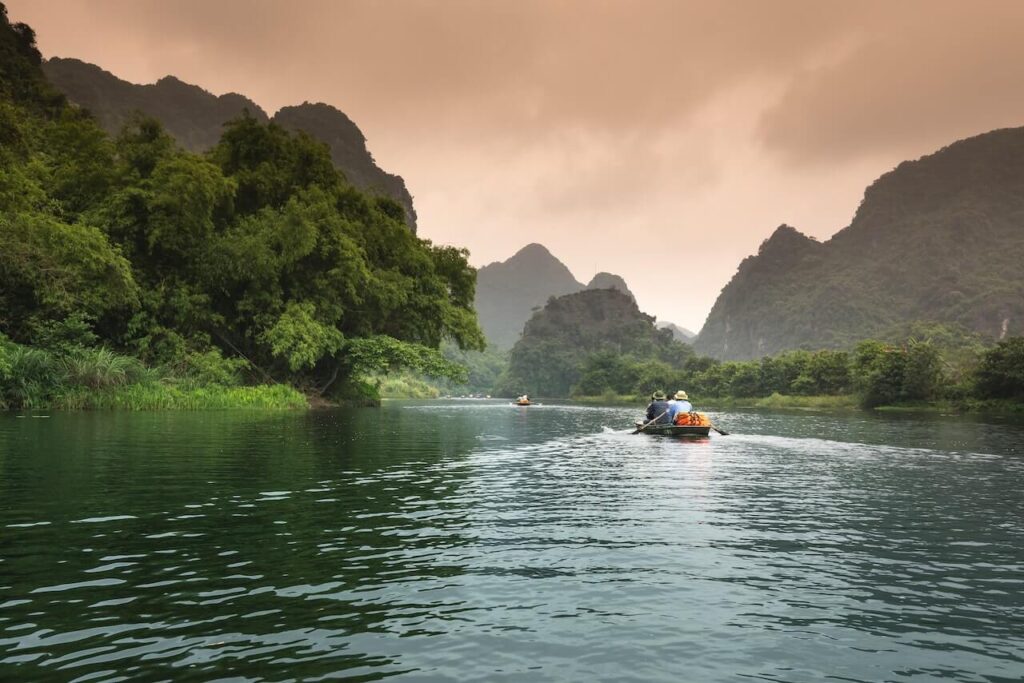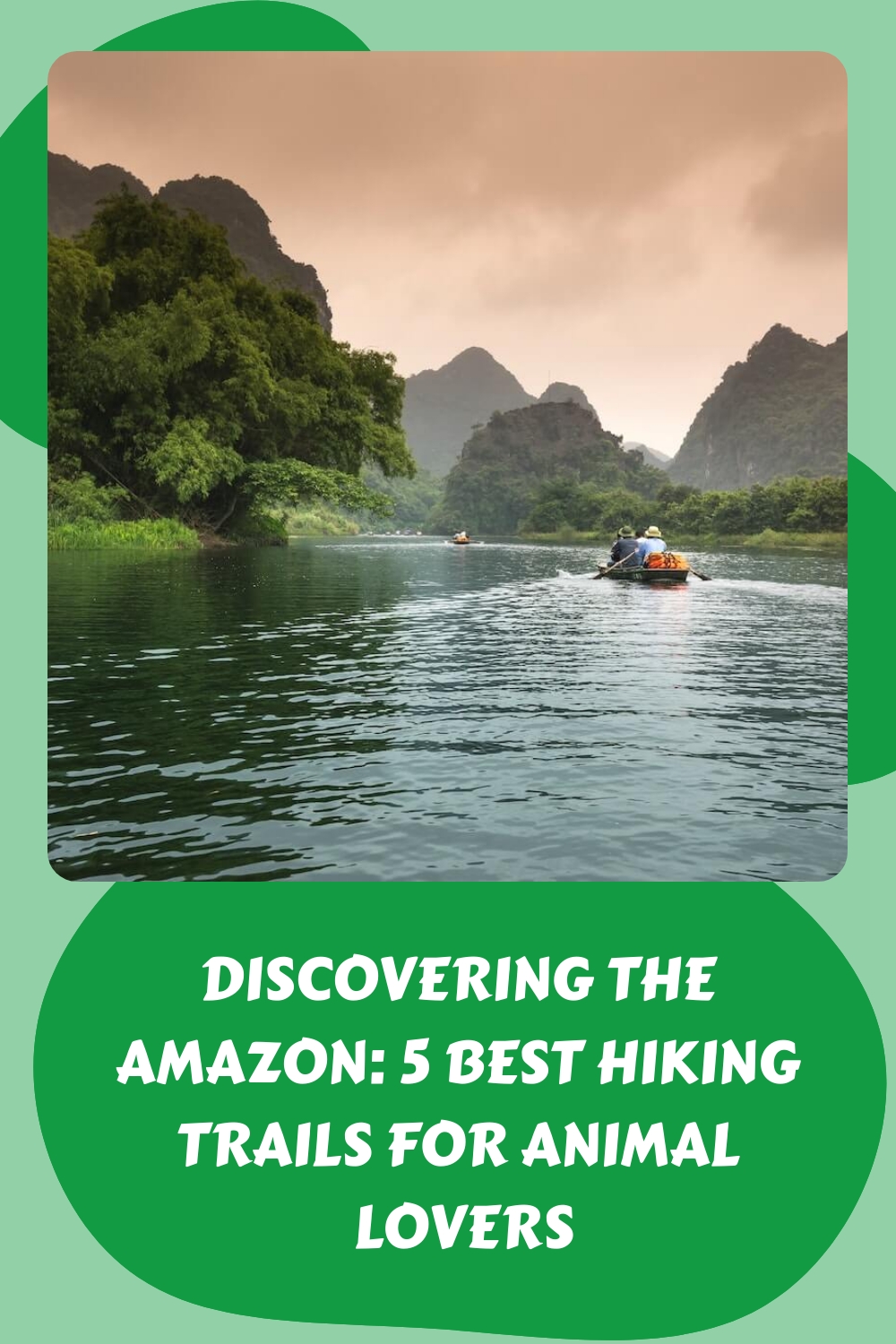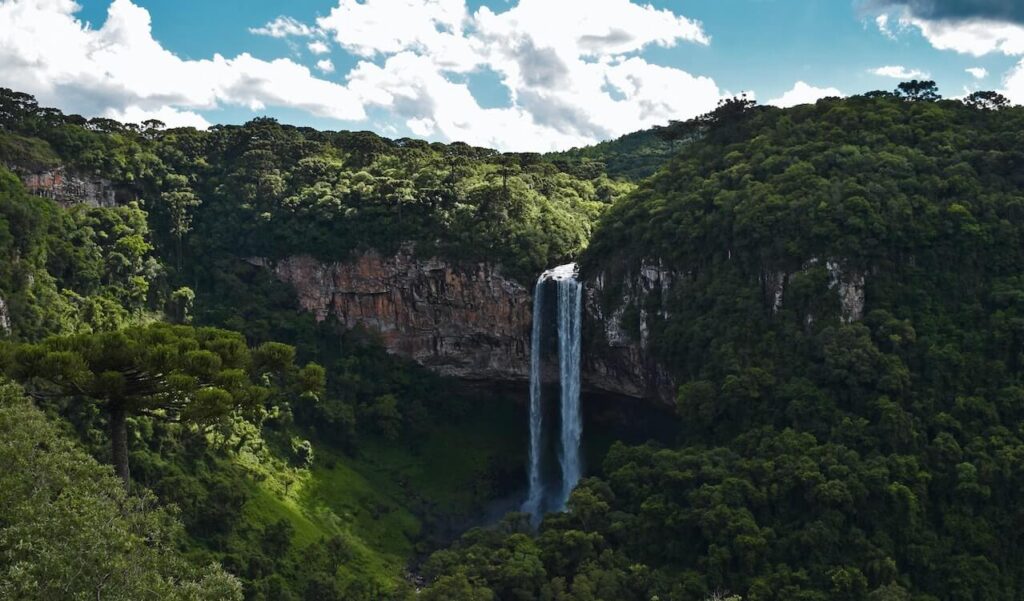
Introduction
The Amazon Rainforest is one of the world’s most diverse and biodiverse regions, home to a staggering variety of plant and animal species. For wildlife lovers, the Amazon is an unparalleled destination for observing animals in their natural habitat. Whether you’re an experienced hiker or a nature enthusiast looking for a new adventure, the Amazon offers an abundance of hiking trails that are perfect for spotting wildlife.
Why the Amazon Rainforest is a great destination for wildlife lovers
One of the main reasons why the Amazon Rainforest is a great destination for wildlife lovers is the sheer variety of species that call this region home. The Amazon is home to more than 2.5 million insect species, tens of thousands of plant species, and over 2,000 bird and mammal species. This means that visitors to the Amazon can expect to encounter a wide range of animals, from colorful parrots and toucans to jaguars, monkeys, and sloths.

Preparing for a Hike in the Amazon Rainforest
What to consider before embarking on a hike:
Before heading out on a hike in the Amazon Rainforest, it’s important to consider several factors to ensure a safe and enjoyable experience. Firstly, research the area you plan to hike in. This can give you a good idea of the terrain, the length and difficulty of the trail, and any wildlife you might encounter. You can also check the weather forecast for the day of the hike to make sure it’s safe to be out in the rainforest.
It’s also important to consider your own physical abilities and limitations. If you’re not an experienced hiker, you might want to start with a shorter or easier trail to get a feel for the rainforest environment. And if you have any health conditions that might affect your ability to hike, it’s a good idea to consult with a doctor before embarking on a rainforest adventure.
Essential items to pack:
When hiking in the Amazon Rainforest, it’s important to pack essential items to ensure a safe and comfortable experience. Some of the essential items you should bring include:
- Insect repellent: The Amazon Rainforest is home to many insects, including mosquitoes, which can carry diseases like malaria and dengue fever.
- Sunscreen and a hat: The rainforest can be very hot and humid, so protecting your skin from the sun is important.
- Sturdy hiking boots: The terrain in the Amazon Rainforest can be challenging, with rocky paths and steep inclines. Good hiking boots will protect your feet and provide support.
- A first aid kit: It’s always a good idea to bring a first aid kit with you on any hike, but especially in the rainforest, where medical facilities may be limited.
- A compass or GPS: The rainforest can be disorienting, so having a way to navigate is essential.
- Plenty of water and snacks: Hiking in the Amazon Rainforest can be strenuous, so it’s important to stay hydrated and keep your energy levels up with nutritious snacks.
Safety precautions to take:
When hiking in the Amazon Rainforest, there are several safety precautions you should take to ensure a safe and enjoyable experience. Firstly, it’s important to stay on the designated trails to avoid getting lost or encountering dangerous wildlife.
It’s also important to be aware of the wildlife around you and to avoid disturbing or approaching animals. Many animals in the rainforest are territorial and can be dangerous if they feel threatened.
5 Best Hiking Trails for Animal Watching in the Amazon Rainforest
The Amazon Rainforest is home to an incredibly diverse range of wildlife, from colorful birds and monkeys to elusive jaguars and anacondas. Hiking in the rainforest is one of the best ways to experience this incredible biodiversity up close. Here are some of the top hiking trails in the Amazon for wildlife spotting:
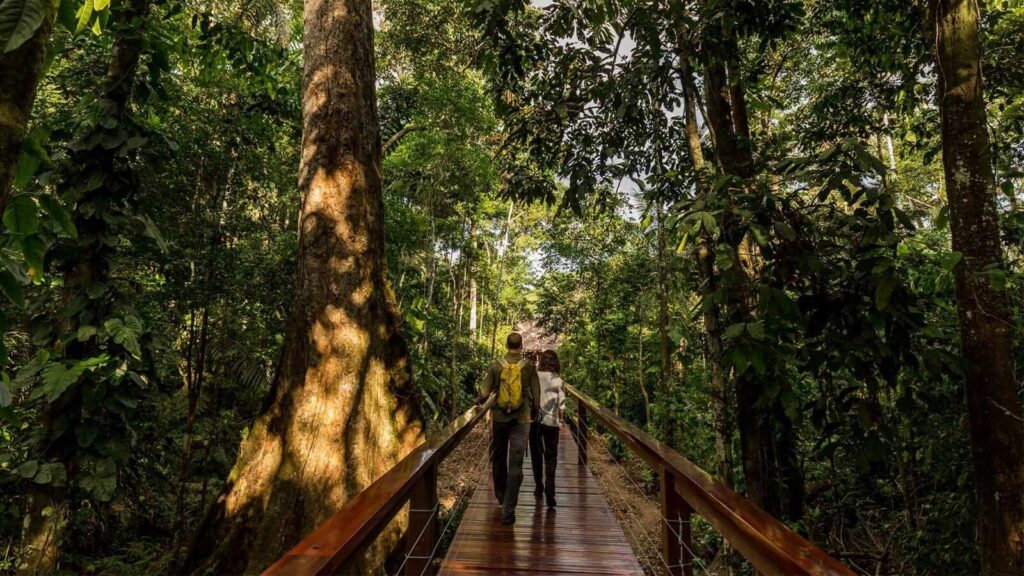
1. Tambopata National Reserve
Tambopata National Reserve is one of the most popular destinations in the Amazon rainforest for wildlife watching. Located in the southeastern region of Peru, this reserve covers over 274,690 hectares of pristine rainforest and is home to a diverse array of flora and fauna. The reserve is home to over 650 bird species, as well as a variety of mammals, including jaguars, giant otters, and capybaras.
The reserve is accessible through the town of Puerto Maldonado and offers a variety of hiking trails ranging from easy to difficult. The most popular trail is the Sandoval Lake trail, which takes visitors through primary and secondary rainforest before arriving at the tranquil Sandoval Lake. Along the way, hikers have the opportunity to spot a variety of animals, including monkeys, sloths, macaws, toucans, and even jaguars.
Another popular trail in Tambopata is the Chuncho Claylick, which offers a unique opportunity to observe parrots and macaws as they come to the clay licks to feed. This is a great activity for birdwatchers who want to see these colorful birds up close.
In addition to hiking, visitors can also take boat tours to explore the rivers and lakes of Tambopata. These tours offer the opportunity to observe aquatic animals like river otters, caimans, and giant river turtles.

2. Manu National Park:
Located in the Madre de Dios and Cusco regions of Peru, Manu National Park is one of the most biodiverse areas on the planet. The park is home to over 1,000 bird species and 200 mammal species, including giant otters, tapirs, and several species of monkeys.
One of the best ways to explore the Manu National Park and observe its wildlife is by embarking on a hiking trail. One popular trail is the Cocha Cashu Trail, which takes visitors on a three-day trek through the rainforest to Cocha Cashu, a lake that is home to an abundance of wildlife. The trail is quite challenging, and visitors must be in good physical condition to undertake it. However, the effort is well worth it as hikers may encounter some of the Amazon’s most iconic creatures, including jaguars, giant otters, and various species of monkeys.
Another popular trail in the Manu National Park is the Macaw Clay Lick Trail. This trail is a favorite among birdwatchers and wildlife enthusiasts as it leads visitors to one of the largest macaw clay licks in the Amazon. Here, they can observe dozens of macaws and parrots congregating to eat clay, which helps them digest toxins found in the nuts and seeds they consume. Visitors may also spot other bird species, monkeys, and even tapirs along the way.

3. Yasuni National Park:
Yasuni National Park is located in the northeastern part of Ecuador and covers an area of over 9,800 square kilometers. It is considered to be one of the most biodiverse places on Earth, with a diverse range of habitats that include rainforests, wetlands, and rivers. The park is home to an estimated 600 bird species, over 200 species of mammals, and thousands of plant species.
One of the top hiking trails in Yasuni National Park is the Kichwa Indigenous Community Trail, which is led by local guides from the Kichwa Indigenous community. This trail takes visitors through the heart of the Amazon rainforest and provides an opportunity to experience the local culture and traditions. Along the way, hikers can expect to see a variety of wildlife, including monkeys, birds, and reptiles. Visitors may also have the chance to learn about traditional plant medicine and other cultural practices.
Another popular hiking trail in Yasuni National Park is the Parrot Clay Lick Trail. This trail takes visitors to a clay lick where parrots, macaws, and other bird species gather to eat the minerals in the clay. Visitors can witness these colorful birds in action and also observe other wildlife in the surrounding rainforest. The trail is accessible year-round, but the best time to visit is during the dry season (June to November) when the clay lick is most active.
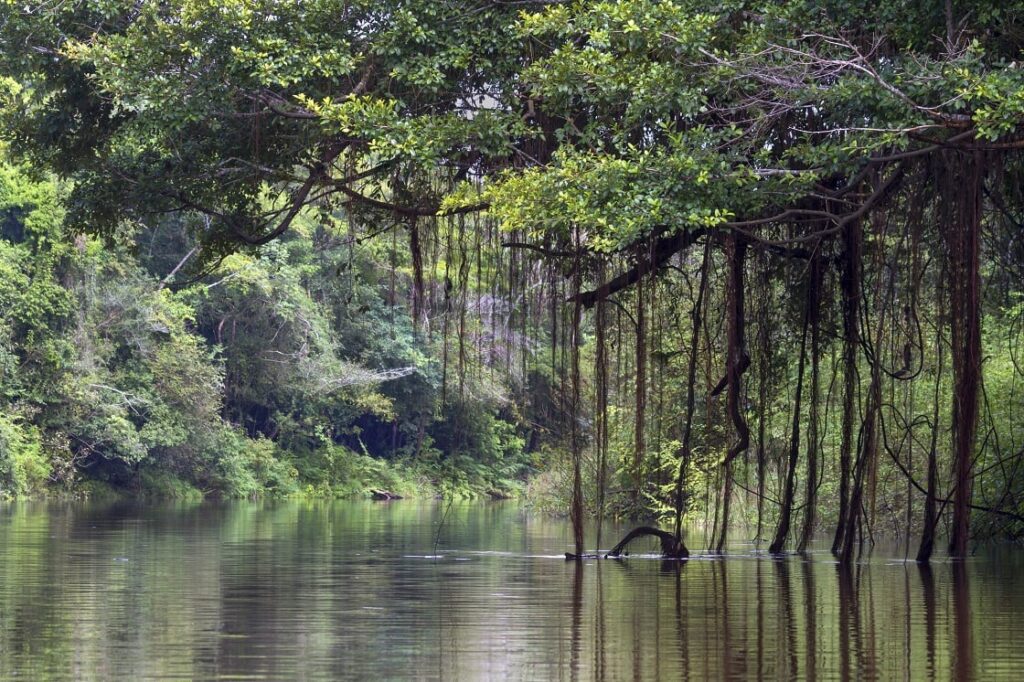
4. Pacaya Samiria National Reserve:
Pacaya Samiria National Reserve is a protected area located in the Loreto Region of Peru, covering over 20,000 square kilometers of rainforest, rivers, and lakes. It is named after two major rivers that run through the reserve, the Pacaya and the Samiria. The reserve is home to a diverse range of flora and fauna, including over 450 bird species, 102 mammal species, and numerous reptiles, amphibians, and fish.
One of the top hiking trails in Pacaya Samiria National Reserve is the Yanayacu Pucate Trail, which takes visitors through a variety of habitats, including floodplains, swamps, and forests. The trail is led by local guides who are knowledgeable about the wildlife and plant species in the area. Hikers may have the chance to see a variety of animals, such as monkeys, sloths, and river dolphins, as well as exotic birds like toucans and macaws.
Another popular activity in Pacaya Samiria National Reserve is the riverboat tour, which allows visitors to explore the reserve’s many rivers and lakes. These tours are typically led by local guides and provide an opportunity to see a variety of wildlife, including caimans, turtles, and various bird species. Visitors can also learn about the local culture and traditions, as many river communities are located within the reserve.

5. Cuyabeno Wildlife Reserve:
Cuyabeno Wildlife Reserve is a protected area located in the Sucumbios province of Ecuador, covering over 6,000 square kilometers of rainforest and rivers. The reserve is home to a rich diversity of wildlife, including over 500 species of birds, 350 species of fish, and numerous mammals, reptiles, and amphibians.
One of the best ways to explore Cuyabeno Wildlife Reserve is through a guided canoe tour along the Cuyabeno River. These tours are typically led by local indigenous guides who have extensive knowledge of the area’s flora and fauna. Along the river, visitors can spot a variety of animals, such as monkeys, sloths, river dolphins, and caimans. They can also see unique bird species, such as the hoatzin, known for its distinctive smell and prehistoric appearance.
Hiking trails in Cuyabeno Wildlife Reserve offer visitors the opportunity to explore the rainforest on foot. One of the most popular hiking trails is the Tarapuy Trail, which takes hikers through a variety of habitats, including lowland rainforest and swamp forest. Along the way, hikers can spot a variety of animals, such as anteaters, armadillos, and peccaries, as well as various bird species like macaws and toucans.
Cuyabeno Wildlife Reserve is also a great place for night walks, where visitors can experience the unique sounds and sights of the rainforest after dark. These walks are led by local guides who use flashlights to spot animals like frogs, tarantulas, and snakes.
Tips for Maximizing Your Chances of Encountering Wildlife:
- Be quiet: Many animals in the rainforest are sensitive to noise, so staying quiet can help you avoid scaring them away.
- Go early in the morning or late in the afternoon: Many animals are most active at these times of day, so your chances of spotting them are higher.
- Hire a local guide: A local guide can help you spot wildlife that you might not notice on your own, as well as provide information about the animals and their behaviors.
- Be patient: Spotting wildlife in the rainforest can take time and patience. Take your time and keep your eyes and ears open, and you’ll increase your chances of encountering some of the Amazon’s most incredible creatures.

Wildlife Watching Etiquette
Observing wildlife in their natural habitat can be a thrilling experience, but it’s important to do so in a responsible and respectful manner. Here are some tips to help you minimize your impact on the environment and ensure a positive experience for both you and the animals:
- Keep a safe distance: It’s important to keep a safe distance from wildlife to avoid disturbing their natural behavior and to ensure your own safety. Many animals can become aggressive if they feel threatened or cornered, so it’s important to give them plenty of space.
- Use binoculars or a camera with a zoom lens: Binoculars or a camera with a zoom lens can help you observe animals from a safe distance without disturbing them.
- Do not feed or touch wildlife: Feeding wildlife can disrupt their natural diet and behavior and may lead to dependency on humans. Touching animals can also spread diseases or cause them to become accustomed to humans, which can lead to dangerous encounters in the future.
- Do not use flash photography: Flash photography can startle and disorient animals, especially those that are nocturnal. It’s best to avoid using flash photography altogether when observing wildlife.
- Respect wildlife habitats: Stay on designated trails and avoid entering areas that are off-limits or marked as restricted. Avoid disturbing or destroying vegetation or disturbing natural habitats.
- Pack out your trash: It’s important to pack out all trash and waste to minimize your impact on the environment. Leave the natural environment as you found it, or better if you can.
- Educate yourself: Learn about the animals you’re likely to encounter and their behaviors, so you can better understand how to observe them without disrupting their natural habitat. You can also learn about local conservation efforts and how you can help support them.
By following these guidelines, you can help protect the wildlife and their natural habitats, while still enjoying the thrill of observing animals in the Amazon rainforest.

Other Activities for Animal Lovers in the Amazon Rainforest
In addition to hiking, there are many other ways to observe and interact with wildlife in the Amazon rainforest. Here are some additional activities that animal lovers might enjoy:
- Boat tours: Taking a boat tour is a great way to explore the Amazon’s many waterways and observe aquatic wildlife like pink river dolphins, giant otters, and caimans. You can also take a boat to access more remote areas of the rainforest that are difficult to reach on foot.
- Night walks: Many animals are more active at night, making a night walk a great way to observe nocturnal wildlife like owls, bats, and night monkeys. Guided night walks can also provide opportunities to see other nocturnal animals that you might not otherwise encounter.
- Birdwatching excursions: The Amazon rainforest is home to over 1,500 bird species, making it a paradise for birdwatchers. Guided birdwatching excursions can take you to prime birdwatching spots and help you identify different species.
- Canoeing and kayaking: Canoeing or kayaking through the Amazon’s waterways can provide a more intimate experience with the rainforest and its wildlife. It’s a quiet and peaceful way to explore the rainforest and observe animals without disturbing them.
- Wildlife rescue and rehabilitation centers: Some areas of the Amazon offer opportunities to visit wildlife rescue and rehabilitation centers. These centers offer a chance to observe and learn about animals that have been rescued from the illegal pet trade or other harmful situations, and to support the conservation efforts to help protect them.
When planning your trip to the Amazon, consider incorporating some of these activities into your itinerary to enhance your experience and get the most out of your wildlife-watching adventure. Remember to always observe animals responsibly and follow the guidelines to minimize your impact on the environment.
Conclusion
The Amazon rainforest is a true wonder of the world, offering an unparalleled opportunity to observe a vast array of wildlife in its natural habitat. Whether you choose to explore on foot, by boat, or through other activities, there are many ways to experience the rich biodiversity of the rainforest.
When planning your trip, it’s important to be prepared, pack the necessary gear, and take safety precautions to ensure a safe and enjoyable experience. Additionally, it’s important to observe wildlife responsibly, following the guidelines to minimize your impact on the environment and respect the animals that call the rainforest home.
By following these tips, you can have a truly unforgettable experience in the Amazon rainforest, while also contributing to conservation efforts to help protect this incredible natural resource for future generations.
Read more articles here.
Generated with Pin Generator
